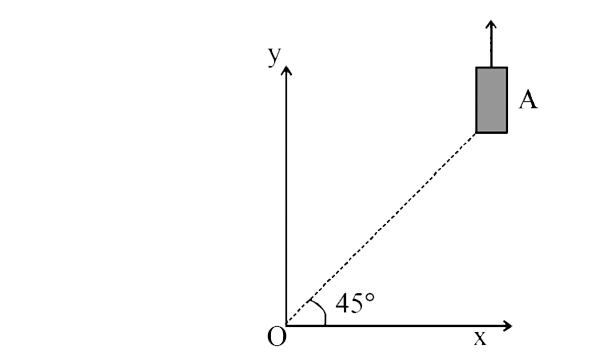Assertion - Component of A along B is equal to component of B along A.
Reason value of component is always less then the magnitude of vector .
If both Assetion and Reason are correct but Reason is the correct explanation of Assertion.
If both Assetion and Reason are correct but Reason is not the correct explanation of Assertion.
If Asserion is true but Reason is false
If Asserion is false but Reason is true
The correct Answer is:D
To solve the question, we need to analyze both the assertion and the reason provided.
Step 1: Understand the Assertion
The assertion states that the component of vector A along vector B is equal to the component of vector B along vector A.
- The component of vector A along vector B is given by the formula:
AB=A⋅B|B|
where A⋅B is the dot product of vectors A and B, and |B| is the magnitude of vector B.
- Similarly, the component of vector B along vector A is given by:
BA=B⋅A|A|
- These two components are generally not equal unless A and B are in the same direction or have the same magnitude. Therefore, the assertion is false.
Step 2: Understand the Reason
The reason states that the value of a component is always less than the magnitude of the vector.
- This is true because the component of a vector is a projection of that vector in a specific direction. By definition, the magnitude of a vector is the longest possible length of that vector, while the component represents only a part of that vector in a particular direction.
- Mathematically, for any vector V:
|V|≥|VB|
where |VB| is the component of vector V along vector B.
Conclusion
- The assertion is false.
- The reason is true.
Thus, the correct answer is that the assertion is false, but the reason is true.
Final Answer
Assertion is false, Reason is true.
---
The assertion states that the component of vector A along vector B is equal to the component of vector B along vector A.
AB=A⋅B|B|
where A⋅B is the dot product of vectors A and B, and |B| is the magnitude of vector B.
BA=B⋅A|A|
The reason states that the value of a component is always less than the magnitude of the vector.
|V|≥|VB|
where |VB| is the component of vector V along vector B.
- The assertion is false.
- The reason is true.
Assertion is false, Reason is true.
Topper's Solved these Questions
Similar Questions
On a frictionless horizontal surface , assumed to be the x−y plane , a small trolley A is moving along a straight line parallel to the y−axis ( see figure) with a constant velocity of (√3−1)m/s . At a particular instant , when the line OA makes an angle of 45(∘) with the x− axis , a ball is thrown along the surface from the origin O. Its velocity makes an angle ϕ with the x− axis and it hits the trolley .
(a) The motion of the ball is observed from the frame of the trolley . Calculate the angle θ made by the velocity vector of the ball with the x−axis in this frame .
(b) Find the speed of the ball with respect to the surface , if ϕ=(4θ)/(3).
 View Solution
View SolutionWrithe the component of →b along →a.
View SolutionThe component of a vector is
View SolutionVitamin B2 is component of coenzyme
View SolutionA vector has component along the X-axis equal to 25 unit and along the Y-axis equl to 60 unit. Find the magnitude and direction of the vector.
View SolutionThe x− component of a certain vector in x−y plane is 2 units and y− component is +2√3 units. What is the magnitude of the vector.
View SolutionCan a vector have zero component along line and still have non zero magnitude?
View SolutionA vector has component along the X-axis equal to 25 unit and along the Y-axis equl to 60 unit. Find the magnitude and direction of the vector.
View SolutionThere are two vectors →A=3ˆi+ˆj and →B=ˆj+2ˆk. For these two vectors-
(a) Find the component of →A along →B in vector form.
(b) If →A&→B are the adjacent sides of a parallalogram then find the magnitude of its area.
(c) Find a unit vector which is perpendicular to both →A&→B.View SolutionRead each statement below carefully and state with reasons, with it is true or false :
(a) The magnitude of vector is always a scalar.
(b) Each component of a vector is always a scalar.
(c) The total path length is always equal to the magnitude of the displacement vector of a particle.
(d) The average speed of a particle (defined as total path length divided by the time taken to cover the path) is greater or equal to the magnitude of average velocity of the particle over the same interval of time.
(e) three vectors not lying in a plane can never add up to give a null vector.View Solution

